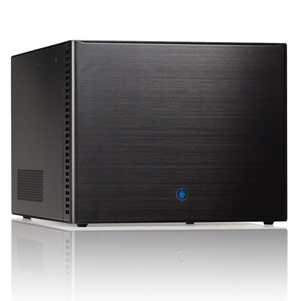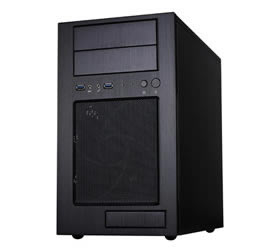File Server Builder's Guide
by Zach Throckmorton on September 4, 2011 3:30 PM ESTAs motherboard layout is important in ensuring that airflow is as unobstructed as possible, case design is also critical in facilitating excellent airflow. If you're building a system with one or two hard drives, most cases work fine for a home file server - just make sure there is a fan near the hard drive(s) so it is not sitting in stagnant air. However, if your server requires multiple disks, here are a few cases that work especially well for file servers.
Mini-ITX

Fractal's Array R2 is a nearly perfect home file server case. At less than 14" deep by 10" wide by 8" tall, it occupies little volume. It positions a removable hard drive cage immediately behind a quiet yet powerful 140mm intake fan. The hard drive cage accommodates up to six hard drives using vibration-dampening silicone mounts, and there is also room for a 2.5" drive (either an SSD or HDD). According to my testing, when stuffed with six low-rpm 2TB mass storage HDDs and one SSD (with an Intel Pentium G620 CPU installed), the temperatures of the HDDs hover around 40C even when all drives are under artificial sustained load (using Iometer). The PSU is a custom SFX form factor model, 80+ efficiency 300W unit with ample amps on the split 12V rail to power six HDDs. The PSU features seven SATA connectors and one legacy molex connector, so there are no extraneous molex plugs and enough SATA plugs. Furthermore, the cables are shorter than typical, so excessive cabling does not interfere with airflow. The case itself is constructed of aluminum so it is lightweight, and its overall build quality is very high. It does not have room for an optical drive, but I consider optical drives superfluous for a home file server. If necessary, you can always hook up a USB interface external optical drive. The only drawback of this case and its PSU is the price: at just under $200, it is not cheap. However, the subjective aesthetics, objective functionality of the case and the custom PSU are worth the cost if you want a small but capacious home file server case.
Micro-ATX

As I prefer home file servers that take up as little space as possible, Silverstone's TJ08B-E is a great, smaller micro-ATX minitower. It's less than 16" deep, 9" wide, 15" tall and weighs less than 12 pounds. It can accommodate up to five HDDs plus one SSD. As with the Fractal Array R2, the hard drives are placed immediately behind a front intake fan - though in this case, it's an even larger 180mm unit. The TJ08B-E is flexible in that it can hold a couple optical drives as well as a GPU in case you want to repurpose or multipurpose it. When stuffed with four low-rpm green drives, the temperatures under load don't exceed 45C during sustained transfers. Overall build quality is very good, like most Silverstone cases.
Silverstone makes a diminutive, fully modular PSU that makes working with smaller cases like the TJ08B-E, Lian Li PC-Q08, and others much easier. Silverstone also offers a short cable kit, making the ST50F-P PSU even better suited to SFF cases. Finally, it's clear that Silverstone had smaller multi-HDD systems in mind when designing the CP06 SATA power plug extension cable. This extender connects to a single SATA power plug and then has four SATA power plugs that are spaced closer than usual together, further reducing cable clutter. Though the cost of these accessories adds up, they make an ideal cabling solution very easy to implement. Regardless of whatever PSU you decide to go with, if you use a split 12V rail model, make sure you don't load up one rail with HDDs. If you go with a single 12V rail model, you'll want that rail to be beefy - for example, don't try to put ten HDDs and four case fans on a budget PSU with a 20A 12V rail.
Full Tower
Very few cases can accommodate ten HDDs at stock (without adding adapters), and such cases are not at all small. Full towers also typically offer excellent airflow, and cable management is not very difficult. Fractal's Define XL is one of the least expensive 10 HDD bay full tower cases available. It is well-built, and extra care has been paid to making the case quiet in the form of panel insulation. It is impossible to hear active HDDs inside this case even when you're sitting just a few feet from it (even the notoriously loud VelociRaptors). Further, there are plenty of integrated niceties like adjustable/flexible cable baffles that assist in cable management. Seven of the ten HDD slots are immediately behind fans, with three slots one cage removed from the front intake fans. Even still, the HDDs that aren't right behind the fans stay cool (between 35C and 40C). At around $150, it is an excellent value. Just make sure you don't pair it up with Silverstone's short cable kit!
We've saved the most important aspect of a home file server - the hard drives - for the next and last component page.











152 Comments
View All Comments
HMTK - Monday, September 5, 2011 - link
I've got one and it happily runs Windows Server 2008 R2, even as a domain controller and Microsoft Security Essentials for AV. Only 1 GB RAM but that's enough for simple file storage. I still have 2 bays free if I need more than the 2 TB mirror I have now. And it has an eSATA port I think.tmensonides - Monday, September 5, 2011 - link
I have a readynas atom as a file server, but have been toying with building an atom based system as 1: A backup for the readynas and 2: a webserver for my wifes business blog (photography)....her blogsite maybe gets 50-75 hits and a max/good day.....Could an atom bases syatem handle that with out super crappy load times?
bobbozzo - Wednesday, September 7, 2011 - link
If you're using wordpress, it can be pretty slow on low-end hardware, but 75 hits is nothing.HMTK - Monday, September 5, 2011 - link
Who's going to have a 10 Gb switch at home? Please get real. Most SMB's don't even have that. Why not go full 8 Gb fiber while you're at it :-)alpha754293 - Tuesday, September 6, 2011 - link
@HMTK12x IB EDR FTW!!!!
(what's up? long time no talk.)
futurepastnow - Monday, September 5, 2011 - link
I'm just going to post the specs of the file server I built a little over a year ago:Windows Home Server (original edition)
Athlon LE-1660 45W processor
2GB DDR2 RAM
Gigabyte 740G mATX mobo
Six WD Greenpower 1TB drives
Antec Sonata case
Corsair 400CX PSU
I originally tried to build a lower power WHS box with an Atom processor, using a PCIe card to add more SATA ports so I could run all six drives. Performance was not satisfactory, drive indexing and balancing took way too long, and (because of the PCIe card) I got no warning that one of the drives was filling up with bad sectors before it died. And due to the slowness of the Atom, not all of my 2+TB of data had yet been duplicated across the six drives.
I replaced it with a very cheap K8 CPU and the cheapest motherboard that had six SATA ports built-in and was from a brand I trust. The Athlon is much faster, although a lower-clocked dual-core would have been better. There are better options for those building today, anyway. I'm still very happy with the server in its current form.
Malih - Monday, September 5, 2011 - link
What about underclocking+undervolting the overheated but cheaper Athlon CPU, that would make it quite power efficient and lower in temps compared with the Pentiums in that regard.I'm hoping some tweaking tips like this in a Builder's Guide article from Anandtech.
GTaudiophile - Monday, September 5, 2011 - link
In the OS section of the article, he writes:"While there is an Ubuntu Server Edition, one of the easiest ways to turn Ubuntu into a home file server is to install and use Samba. (Samba can be used on not only Ubuntu, but also FreeBSD.)"
I am confused by this a little bit.
SAMBA is by no means exclusive to Ubuntu or any other distro. In fact, I use SAMBA shares through FreeNAS and it works quite well. I just think the article alludes (to the lay-person) that SAMBA is somehow exclusive to Ubuntu and it is not.
Secondly, why does the article not touch on NFS at all? From what I understand, NFS is faster and more reliable than SAMBA.
Braumin - Tuesday, September 6, 2011 - link
For the average person, WHS 2011 is just the easiest way to go. If someone is moving up from a NAS, then they don't just want file storage. WHS offers great and pain free PC backups with image based restores, a great remote access page with full SSL, and it is dead easy to configure and use.I think the comments have gotten a bit out of hand with various RAID incarnations that people have. Most people don't need RAID. They need centralized file storage, and then need a backup. WHS does both. It also supports RAID if you really need it.
I have to say, I would rather see a bit more in depth on this topic. It is important for many people these days since everyone seems to have at least two computers per house, if not more.
semo - Tuesday, September 6, 2011 - link
I think that an article of such nature should go in a lot more depth in regards to backups (strategies, equipment and best practices).